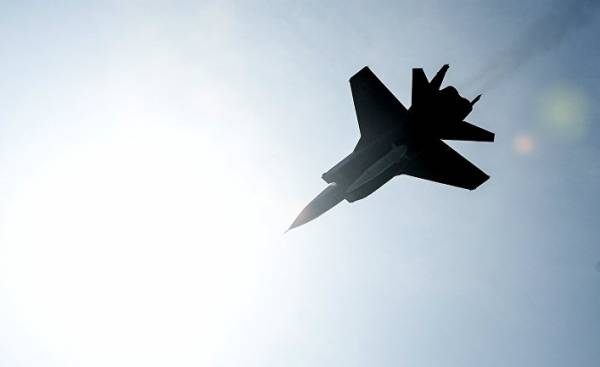There’s a famous Russian saying: “Everything new is well forgotten old”. As an example, you can give the MiG-31. This seems to be outdated workhorse, where 40 years may get a second or even third life.
The MiG-31, which in the 1980-ies performed the tasks in the pursuit of the American reconnaissance aircraft SR-71 in the sky over the Soviet Arctic at a whopping altitude of 19 kilometers, was officially converted and became a delivery vehicle hypersonic missiles “Dagger”, thanks to which, according to Vladimir Putin, Russia will return to the global arms race.
But in this little intrigue. In fact, experts on military aircraft for the last two years resulting in the extraordinary excitement of the photo posted online an unofficial spies everywhere, loving to poke his nose. It MiG-31 is flying with the mysterious missile, which in appearance is even more “Dagger”, although the “Dagger” a little will not name. It weighs half a ton, and can fly nearly 2,000 kilometers.
Commentators suggested that this new and larger missile is designed to output in low-earth orbit, where satellites are flying the US and its allies. In April 2020, the British scientist Bart Hendricks (Bart Hendrickx) published in the online version of “space Review” (The Space Review) a hypothesis based on the analysis of Russian military contracts and hard official statements. His conclusion is that the MiG-31 is actively involved in the implementation of a secret Kremlin plan to deal with the satellites under the name “Petrel”. For reference: Petrel is a despising of the storm bird immortalized in his written in 1901, an epic poem by Maxim Gorky.
Why the choice fell on the MiG-31? First, it is big. You could even say huge. The first time he took to the air in 1981, with a weight of 42,000 pounds, that is, one and a half times more Soviet contemporary of the su-27. He had four rockets R-33 which is only 10 pounds lighter than “the Dagger”. The MiG-31 is also one of the fastest on today’s aircraft. Flight in cruise mode, it does with speed M=2,4 (2 is 960 km/hour), and during the pursuit of a goal can reach speeds in excess of M=2,8. His range on the fuel was 1 of 250 kilometers, and then, from the mid-1980s, he began to refuel in the air.
That speed, the MiG-31 achieves by the fact that flies at an altitude up to 20 kilometers, where the air resistance is minimized. Closer to the surface of the earth it flies slower, but still reaches speeds of M=1,2. Its missiles R-33 can hit targets (in theory) at a distance of 300 kilometers. This combination of speed and deadly firepower “Fox hound” (NATO codification) in those days gained respect and credibility with a potential enemy of the Alliance. Group of four MiG-31 was enough to ward off a pesky foe from the site of the Soviet border length of 900 kilometers.
Again, this is theoretically. No one ever checked.
The main drawback of the MiG-31 was the lack of versatility. It was intended to prevent air attacks on Soviet territory that was unlikely even in the tense 80-e years, and allegedly did not allow American SR-71 into Soviet airspace. But with the advent of multi-role fighters su-27 and their American contemporaries, the F-14 and F-15 MiG-31 in their background began to look decidedly single-purpose. “He looks more like a missile “earth-air”, than on the plane,” says Michael Coffman (Michael Kofman), head of the Russian studies program at Washington analytical organization Center for naval analysis.
Being too big and clumsy to use in a dogfight and in local conflicts after the cold war, the MiG-31 has remained unclaimed, while the other Russian armaments began to make the country money, by doing on the export. For four decades, the MiG-31 has not made a single trigger in a combat situation and not earned for the Kremlin, not a single ruble at the expense of export deliveries.
Today’s conflict is a different story, because “blind” enemy in the sky became an important goal to achieve superiority on the battlefield. To shoot down satellites from fighter jets — this is not a new idea. The USAF at least once successfully did it in the days of “star wars” in 1980-e years, destroying a decoy missile ASM-135A, running with the F-15. Tips to answer intended to adopt a modified MiG-31 with rocket 79М6. This aircraft underwent a few flight tests, but then came perestroika, and all these plans were shelved. If you believe the propaganda of Russian missiles “Dagger” has a range of 1 930 km, which corresponds to the maximum altitude of a satellite in low earth orbit. Therefore, we can with some certainty claim that huge rocket X in Zhukovsky is relative “Dagger”, converted to strike in space.
If someone stands in the orbital objects in this phenomenal removal, the use of the mobile platform, located at an altitude of 20 kilometers, offer significant benefits. Rocket launch from such a height allows to save huge amount of energy (and money). Not less important is the fact that the MiG-31 can destroy satellites 24 hours a day, seven days a week, says Todd Harrison (Todd Harrison), working as the project Director for aerospace safety at the Washington Center for strategic and international studies. “The land-based systems have to wait for the onset of the moment when the satellite will pass within their reach, — he explains. — The launch of the aircraft provides better opportunities”.
Many of the most important satellites of the USA and NATO make orbital flight beyond the reach of “Dagger” and Kh, being in a geostationary or medium-earth orbit (there is GPS satellite constellation). But in low earth orbit there are many satellites that need to be closer to the theater of war to get it pictures in high resolution, says Coffman. From such a satellite today heavily depend troops on the battlefield, as well as ordinary citizens using home Internet. “We are very dependent on space-system-based, as they help direct high-precision weapons, provide target tracking in real-time, and this is extremely important in modern conflict,” he said.
The Russian military will have to work hard and spend a huge amount of rubles before the MiG-31 will be able to solve the problem of the neutralization of these goals. But the ability of the aircraft to carry on Board the new heavy missiles gave this aging machine for another postponement in the execution of the death sentence. In 2015, the Russian Ministry of defence announced its intention to 2030 to modernize 130 aircraft, bringing them up to the level of the latest modification of the MiG-31BM. So, the monster continues to roar.
By the end of the 1970s, the Soviet Union began an internal stagnation and decline. But he had the will and substantial funds in order to keep up with US in a powerful arms race of the superpowers. “The Soviet Union collapsed at the peak of its technological power”, — said Kofman.
Direct accelerator of the process of creating the MiG-31 was the fact that the West in 1976, took control of the aircraft and the predecessor of the MiG-25 when the pilot Viktor Belenko flew to Japan and asked for political asylum. Belenko revealed many secrets about the shortcomings of this machine, as well as its strengths. Analysts of the free world inspired the awe of the unfathomable speed of this aircraft, amounting to M=3. But it turned out that this is nothing more than a show. “At a speed of M=2.8 engines overheated, and the four missiles “air-air” under the wings of the machine began to vibrate dangerously,” — said in the historical narrative on the website Russia Beyond the Headlines. (And the plane was freezing windshield, because the equipment drank alcohol prevents such freeze-up).
MiG-31 prepared for flight tests in three years after these revelations, adding considerable improvement. His engines have less thrust, but they began much more reliable. The body of the aircraft is lengthened to accommodate the second crew member, who was involved in navigation devices and weapons. But the most impressive innovation was the radar “Barrier”, which was the first passive radar with scanning antenna array, installed on the fighter. On the show in 1991, when the peaceful atmosphere gave the MiG-31 the opportunity to appear at the Paris air show radar “Barrier” has aroused the envy of all who met her. About it in his memoirs, wrote test pilot Valery Menitsky.
Zaslon can track six targets simultaneously (though the MiG-31 carried on Board a total of four missiles). Very importantly, the radar could detect and defeat targets in the lower hemisphere of the with missiles R-33, which were installed on the MiG-31 to counter with goals at lower altitudes, say, cruise missiles. The MiG-25 could launch rockets up.
 © RIA Novosti, Grigory Sysoev | go to photobacteria MiG-31 with hypersonic missiles “Dagger”
© RIA Novosti, Grigory Sysoev | go to photobacteria MiG-31 with hypersonic missiles “Dagger”
However, the rush to the creation of the MiG-31 and inordinate ambition took its toll. Menitsky almost died during a test flight, when things went wrong. Sensor the amount of fuel mysteriously pointed to zero, Menitsky made an emergency landing in Zhukovsky without traction at speeds of 470 miles an hour, destroyed the concrete fence on the runway and traveled over a mile until stopped. Getting out of the car alive and unharmed, Menitsky and his co-driver nervously lit a cigarette, but alarmed by the fire grabbed a lit cigarette from their mouths. The fact that the fuel of the plane is not over, and they were standing right in the puddle of kerosene.
Supervisor of Menitsky chief test pilot Alexander Fedotov MiGs are less fortunate. This was already after the era of glasnost, wrote the Russian historian Andrei Simonov. On a modified MiG-31, which Fedotov had experienced in 1984, again there was a failure of the fuel system. Already in the first minutes of flight sensors showed that all the tanks are empty. Fedotov also started to return to the airfield to make an emergency landing without engines. But in reality, in the tanks of the aircraft was 12 and a half tons of fuel. With such a huge weight and in free fall, the car exploded upon impact with the ground. Fedotov, who from the beginning of 1960-ies have tested all the models of MiGs, and received the highest award — the title of Hero of the Soviet Union, tried to jump out with a parachute, but survived. With him died the co-pilot Valery Zaitsev.
The MiG-31 didn’t deserve proper respect for their breakthrough engineering solutions, and this is not helped even the death of his friend, complained Menitsky. Him from the start overshadowed the su-27, about which the commentators on military parades “pains for six or seven minutes”, and the MiG-31 was paid not more than half of the proposals. “Some managers of the company Sukhoi and their lobbyists from the Ministry of defence has supported the campaign launched by the chief designer, who brought to Shine the image of the su-27 to the detriment of the MiG-31”, — was indignant Menitsky in his memoirs.
There is some truth to that, says Professor Ilya Grinberg (Ilya Grinberg), who teaches engineering technology at the state University of new York at Buffalo dissertations in the field of civil engineering in Moscow state University. Legendary designers Artem Mikoyan and Mikhail Gurevich, the MiG gave the letters “M” and “G” – died in 1970-ies. Their successor Rostislav Belyakov, “believed that the products the Moment she works”. But the boss of Sukhoi Mikhail Simonov “was a master of fraud and lobbying”. But lighter and more agile su-27 is better suited for the new era that began after the cold war. Russia’s exports of this aircraft and its modification of the su-35 is almost a dozen countries, and also sold China a license to manufacture its analogue J-11.
But there was one task which could handle only the MiG-31 can chase the SR-71 along the endless borders of the Soviet Union and hold “Blackbird” at a respectful distance from the airspace of the USSR. The CIA has initiated the development of this reconnaissance aircraft on the famous enterprise of the company “Lockheed” “”skunk Works” after the Soviets in 1960, was shot down U-2 and Francis Gary powers with a seemingly unattainable height of 19 kilometers. First SR-71 part of the U.S. air force to perform flights in the skies of Vietnam, and in 1976 switched to tracking Soviet warships, flying the Northern route from the air base Mildenhall in Britain and “far East loop” from the California base was Beaten.
Soviet air defenses could not even be hoped that they will be able to shoot down the SR-71 from the ground. The new aircraft could fly and take pictures at the height of 24 kilometres or more by developing an unheard-of speed of M=3,3. “It was a completely different threat,” says Greenberg. The SR-71 could fly with impunity anywhere.
Well, not quite with impunity, if he was in pursuit of the MiG-31. He was lost to the American three to four kilometers in height and about 560 kilometers per hour for speed. But interacting squadron could keep a lonely flying the SR-71 within launch range of its missiles, especially since the Americans followed more or less on the same route, to better observe objects intelligence. “If the SR-71 violated Soviet airspace, be sure to be followed by the start of combat missiles, recalled pilot Michael Soft, as in his book, “the”Blackbird”. Beyond the secret missions” (Lockheed Blackbird: Beyond the Secret Missions) written by Paul Krichmar (Paul Crickmore). — This plane has not had almost any chance to get away from the R-33″. The pilots of the SR-71 never tried to verify boastful statements Soft. Periodically, they “tickled” the border, but never crossed, recalled the Soviet commander.
So, at the last stage of the cold war in the years of Reagan, the world’s fastest plane twice a week, arranged a secret supersonic ballet in the skies above the harsh New Land, and the White sea. Soft once so close to the enemy aircraft that could see it with the naked eye, save on printing data from the black box. “Contrail at a height of 22-23 thousand meters a rarity, — he wrote. But that day the weather was excellent, and the air was transparent. I went under the plane, he was above us 3 000 — 4 000 meters, and I even managed to see his black silhouette”.
Among other things, the pursuit of the SR-71 gave scattered in isolated and bleak bases from Murmansk to Kamchatka crews of MiG-31 the feeling of being wanted and usefulness, which bordered on confusion about the immensity of the task. Menitsky in his memoirs, imagined that his colleagues from the U.S. air force living in fear. “The MiG-31 was shocked pilots who flew the SR-71, he wrote. They reported everything to his superiors that experience psychological stress from flights along Russian borders and asked to change the routes in the far East. Soon, these flights have stopped.”
More objective historians hold a different opinion. It’s not even clear if you knew that the American pilots that they are pursued by the MiG-31. This is evidenced by the Ukrainian expert at the Russian military aviation Valery Romanenko who helped Krichmar conduct research when writing a book about the SR-71. Taking in 1989, a “Blackbird” with arms, American generals referred to the high cost of the machine, as well as the emergence of intelligence from satellites.
Having lost the main enemy and the generous funding of the Soviet military-industrial complex, which collapsed two years later, the MiG-31 was faced with serious difficulties. According to available information, China in 1992 was thinking about buying 24 machines, intending to copy them at home, but then decided to buy su-27. It was another blow to the Menitsky and other staunch fans of the Moment. Valery Romanenko once talked with Nigerian officials from the Department for the purchase of weapons, who wanted to buy a MiG-31 to perform tasks for long-range radar detection. He dissuaded them. According to Romanenko, the number of existing regiments flying the MiG-31 was reduced from seven to two. This fleet of 14 cars crashed and burned in the period 1995 to 2016, as evidenced by the official reports, proven by Greenberg and Romanenko. However, in all cases, the pilots, thank God, survived.
The first hints of the return of the MiG-31 appeared in 2009, as evidenced by Bart Hendricks. Then the commander of the Russian air force announced that this car “upgrade to perform the same tasks in space, as in Soviet times.” Before the start of the 2017 new information on this subject almost did not arrive. And suddenly another senior military commander said in the pages of the military newspaper “Zvezda”, installed on the MiG-31BM new missile “can hit targets in near space”.
The intrigue intensified in March 2018, when Putin announced the existence of a “Dagger”. In July of the same year, the Agency TASS said that the MiG-31 with the new hypersonic missiles, conducted military exercises, and called these aircraft “the main carriers of hypersonic missiles “Dagger””. In September there was a sensational photo of the MiG-31 with rocket-X under the belly, which was published by the Russian paparazzi, using the tag ShipSash.
Do these disparate clues that the MiG-31 will be a key component of the military Arsenal of a resurgent Russia due to the fact that the battlefield is moved to low-earth orbit? Space will certainly become the theatre of war, if the major powers will again enter the fray and destroy the satellites in this case is quite simple. In the end, they have a constant orbit, and evade the blows it would be very difficult.
Another question, what is the use of destroying enemy satellite.
In the framework of the American program to combat in space, conducted in 1980-ies, was destroyed by only one test satellite. The cause of a large amount of space debris after impact which can cause damage to any of the 1 000-odd vehicles, which are currently in low-earth orbit, says Harrison. “The anti-satellite weapon air-launched is a serious and noteworthy threat, and I’m not sure that the Russian will use it in this orbit”. He believes that the future of lasers that temporarily blind satellites, not delivering them to pieces. Directed energy weapons can also be used secretly, as a victim country does not want to attack openly. “If we have something to say, it will be a recognition of the effectiveness of the attack, explains Harrison. — Therefore, most likely, no one will know anything”.
Russia may also try to blind the enemy, using anti-satellite missile, ground-based “Nudol” placed at the launch site in Plesetsk. In 2014, Russia spent at least 10 tests of the system.
If Russia really wants to incapacitate the enemy satellite, it will be able to do it without a high-altitude aircraft 40 years of age. But it would be a mistake to underestimate “Fox hound”. It is appropriate to recall the Russian proverb: “Everything new (and in this case dangerous) — is well forgotten old”.






